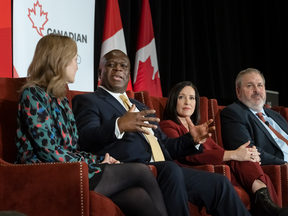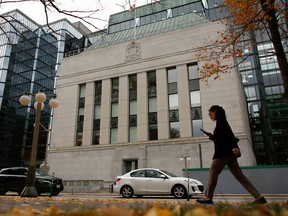Economy still in a soft patch as interest-rate increases weigh on indebted households, restrain spending

Article content
The Canadian economy rebounded slightly last month but still saw little growth, backing a case for the central bank to keep rates on hold despite inflation remaining elevated.
Preliminary data suggest gross domestic product edged up 0.1 per cent in August, Statistics Canada reported Sept. 29 in Ottawa, as declines in the retail and oil and gas industries partly offset increases in the wholesale and finance sectors.
Advertisement 2
Article content
Article content
That followed a flat GDP reading in July, which missed expectations for a 0.1 per cent increase in a Bloomberg survey.
Bonds rallied after the numbers were released, driving the Canada two-year benchmark yield to 4.876 per cent, down more than 4 basis points, the lowest intraday level since Sept. 19.
The economy is now on track to expand at a 0.2 per cent annualized rate in the third quarter, if September output is flat. That’s weaker than the 0.4 per cent consensus estimate in a Bloomberg survey.
Although that means Canada could escape a technical recession with this rebound after a second-quarter contraction, the pace of growth is far weaker than the 2.6 per cent seen during the first three months of this year.
The report points to an economy that’s still in a soft patch as interest-rate increases weigh on indebted households and restrain spending. It leaves room for the Bank of Canada to hold short-term borrowing costs steady in late October, despite a worsening inflation backdrop.
The consumer price index rose four per cent in August, the second straight month of acceleration and double the central bank’s target, with core inflation still elevated.
Article content
Advertisement 3
Article content
Governor Tiff Macklem and his officials were counting on softer consumer activity to translate into slower price increases in the coming months. They stepped to the sidelines in a rate decision in early September, saying excess demand in the economy was easing. Friday’s data support that view.
“While inflationary pressures remain sticky above the Bank of Canada’s target range, the slowing in the economy should give central bankers confidence that their medicine is slowly working,” Royce Mendes, head of macro strategy at Desjardins, said in a report to investors. “As the economy continues to cool from the lagged impacts of rate hikes, price pressures should dissipate further.”
Manufacturing slump
This is the only GDP release before the next rate decision on Oct. 25, when the bank will also release a new set of economic projections. The majority of economists in a Bloomberg survey expect it to hold the policy rate steady at five per cent, with five out of 30 forecasters seeing a 25 basis-point hike.
In July, services industries rose 0.1 per cent, while goods-producing sectors contracted 0.3 per cent.
Advertisement 4
Article content
The manufacturing sector — which had the largest negative contribution in July — declined 1.5 per cent, the second straight monthly contraction, due to lower inventory formation. The port strike in British Columbia affected the chemical manufacturing the most, with the subsector seeing a 3.6 per cent decrease.
Transportation and warehousing contracted 0.2 per cent, with air transportation being the largest contributor to the sector’s decline. Professional, scientific and technical services contracted 0.2 per cent, the first time in eight months.
Oil and gas extraction rose 1.5 per cent in July, up for the sixth time in the last seven months. Finance and insurance rose for the third consecutive month, up 0.3 per cent. Real estate, rental and leasing edged up 0.1 per cent, continuing growth since November 2022.
Mining, excluding oil and gas, and accommodation and food services grew in July, after experiencing declines a month earlier due to forest fires. The former increased 4.2 per cent and the latter rose 2.3 per cent.
Related Stories
-

Canadian economy to get ‘back on its feet’ next year
-

Canada’s population grew by a million last year
-

Economy doing better than expected: OSFI chief
“While some disruptions have compromised the ‘cleanliness’ of recent GDP data, the bigger picture is that Canada is really struggling to grow right now,” Robert Kavcic, an economist at the Bank of Montreal, said in a report to investors. He added that real GDP looks “even weaker” when considering that the population is exploding.
“The Bank of Canada still has their eyes on stubborn core inflation and firm wage growth, but struggling growth argues for them to remain on hold and lean on the tightening that has already been put in place.”
Bloomberg.com
Article content
Canada economy growth misses, backs Bank of Canada interest rate pause
2023-09-29 13:40:52





Comments
Postmedia is committed to maintaining a lively but civil forum for discussion and encourage all readers to share their views on our articles. Comments may take up to an hour for moderation before appearing on the site. We ask you to keep your comments relevant and respectful. We have enabled email notifications—you will now receive an email if you receive a reply to your comment, there is an update to a comment thread you follow or if a user you follow comments. Visit our Community Guidelines for more information and details on how to adjust your email settings.